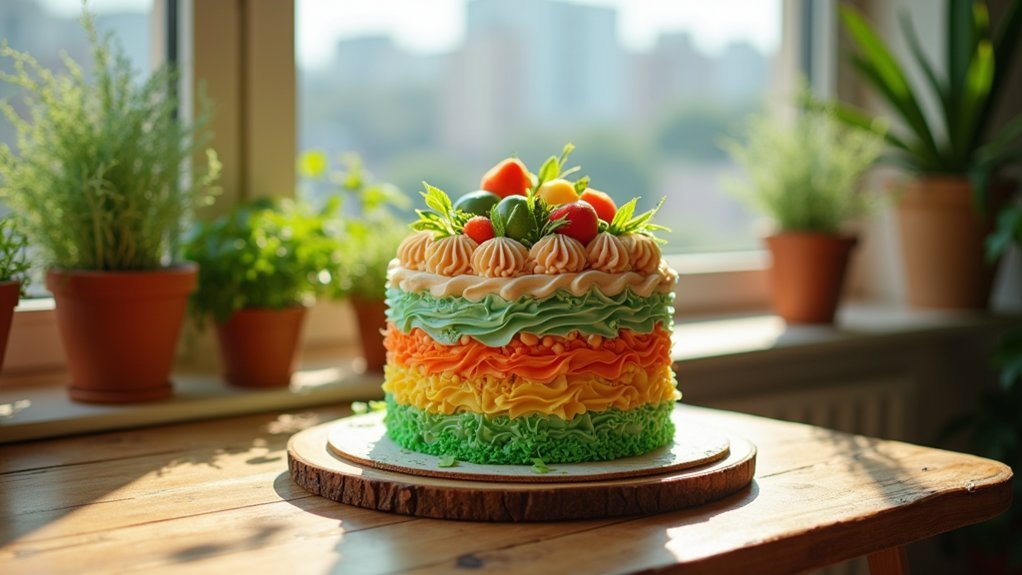Why Sustainable Cake Packaging Matters in 2025
Sustainable cake packaging is crucial in 2025 as consumers increasingly prioritise eco-friendly options. With 70% of shoppers willing to pay a premium for sustainable products, opting for biodegradable and plant-based materials is not only ethical but also a savvy business decision. Gen Z and Millennials are particularly attracted to distinctive, eye-catching designs that align with their values. By embracing these trends, you can boost brand loyalty and build trust with your customers. Innovative materials and creative packaging strategies can help you stand out in a competitive market.
Key Takeaways
- Sustainable cake packaging is increasingly important as 70% of consumers are willing to pay more for eco-friendly options by 2025.
- Using biodegradable materials helps reduce environmental impact, limiting toxic exposure and promoting health and safety for consumers.
- Innovative packaging designs, like minimalist styles and interactive features, can boost consumer engagement and brand loyalty, especially among younger shoppers.
- Being transparent about sustainability efforts builds trust, creating strong connections between brands and customers who value eco-consciousness.
- Partnering with eco-friendly suppliers and investing in sustainable materials not only ensures compliance with new regulations but also supports long-term business growth.
The Growing Importance of Sustainability in Consumer Choices

Sustainability is now a key factor in how consumers make choices. Many of us are gravitating towards brands that emphasise eco-friendly sourcing. In fact, research shows that 72% of consumers worldwide are willing to spend more on environmentally friendly products. This highlights that sustainability isn’t merely a trend, but a vital consideration. Additionally, nearly 50% of consumers are willing to pay 59% more for eco-conscious products, further demonstrating the growing demand for sustainable options. As organic cakes often support sustainable agriculture, this further enhances their appeal among health-conscious consumers.
As you look for environmentally responsible options, understanding what makes a product sustainable is crucial. Choosing brands that are transparent about their practices, especially regarding their impact on climate change, allows you to make informed decisions.
Health and Safety: The Case for Eco-Friendly Packaging
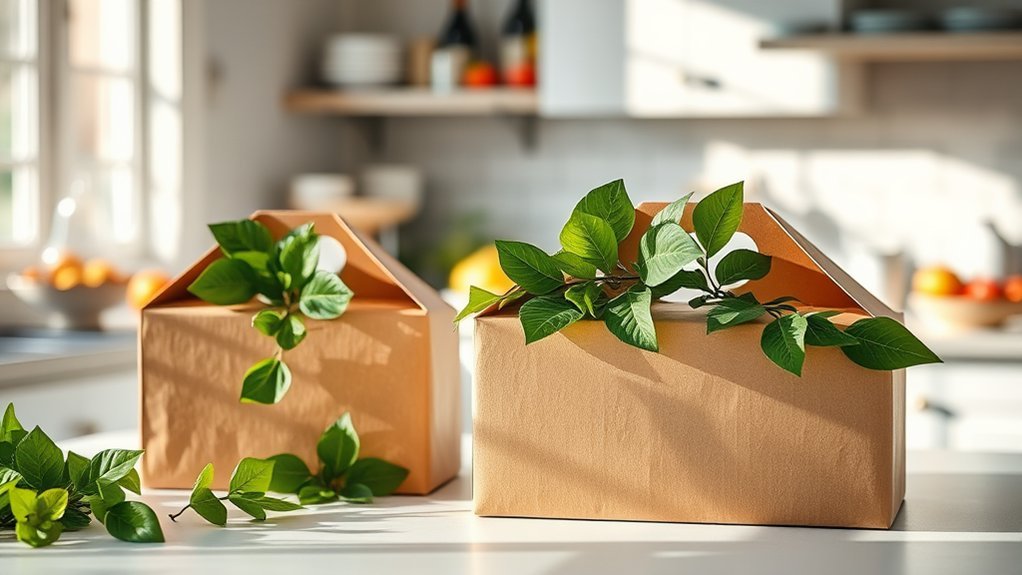
As consumers increasingly value sustainability, health and safety are closely linked to eco-friendly packaging. Choosing biodegradable materials reduces health risks associated with toxic exposure from traditional plastics. For instance, packaging made from plant-based materials is free from harmful chemicals, aligning with the safety standards that consumers expect today. This shift not only boosts consumer confidence but also lowers the risk of exposure to cancer-causing agents. Moreover, sustainable packaging helps reduce microplastics and prevents soil contamination, which is essential for protecting both our environment and health. As awareness of the dangers posed by plastics grows, many consumers are willing to pay a premium for safer packaging options. Additionally, utilizing biodegradable materials ensures that packaging decomposes naturally without leaving harmful residues. Furthermore, organic farming practices contribute to a healthier environment, supporting the demand for sustainable options in the market.
The Influence of Gen Z and Millennials on Packaging Trends

Sustainability is a key factor in consumer choices, and Gen Z and Millennials are significantly influencing packaging trends. Their expectations urge brands to adopt eco-friendly options that align with their values.
Here are some key points to consider:
- Aesthetic Appeal: Gen Z favours distinctive, authentic designs that showcase individuality.
- Digital Sharing: Millennials use social media to highlight visually striking, sustainable packaging, helping to tell brand stories. The importance of visual appeal in packaging design is critical to capturing attention and engagement. Additionally, the use of eco-friendly packaging solutions can further enhance a brand’s reputation among these demographics.
- Value-Based Purchases: Both generations are prepared to spend more on products that reflect their principles, which strengthens brand loyalty.
Innovative Materials: Redefining Aesthetics in Cake Packaging
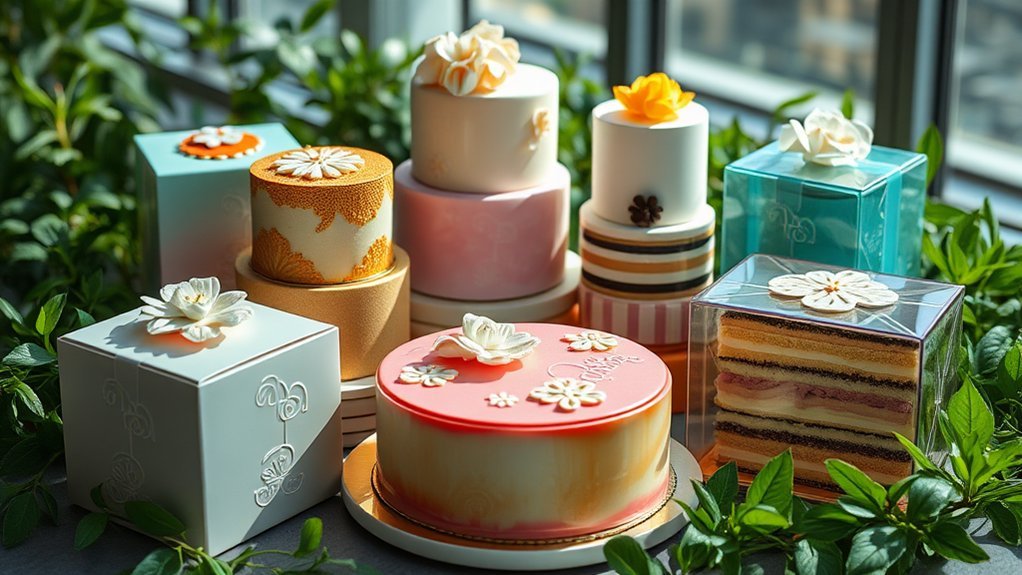
Gen Z and Millennials are not only pushing for sustainable packaging; they’re also transforming the aesthetics of cake packaging with innovative materials. Options like mushroom-based materials and seaweed solutions are leading the way, offering eco-friendly choices that are both attractive and practical.
| Material Type | Benefits | Aesthetic Appeal |
|---|---|---|
| Mushroom-Based | Biodegradable, reduces waste | Unique textures |
| Seaweed Solutions | Compostable, marine-friendly | Organic, flowing designs |
| Sustainable Paper | Eco-friendly alternative | Clean, minimalist look |
| Compostable Boxes | Plant-based, reduces landfill | Stylish and functional |
| Biodegradable Plastics | Quick breakdown, less harmful | Versatile and modern |
These materials not only benefit the environment but also enhance your cake presentation, appealing to eco-conscious consumers.
Economic Advantages of Sustainable Packaging Solutions
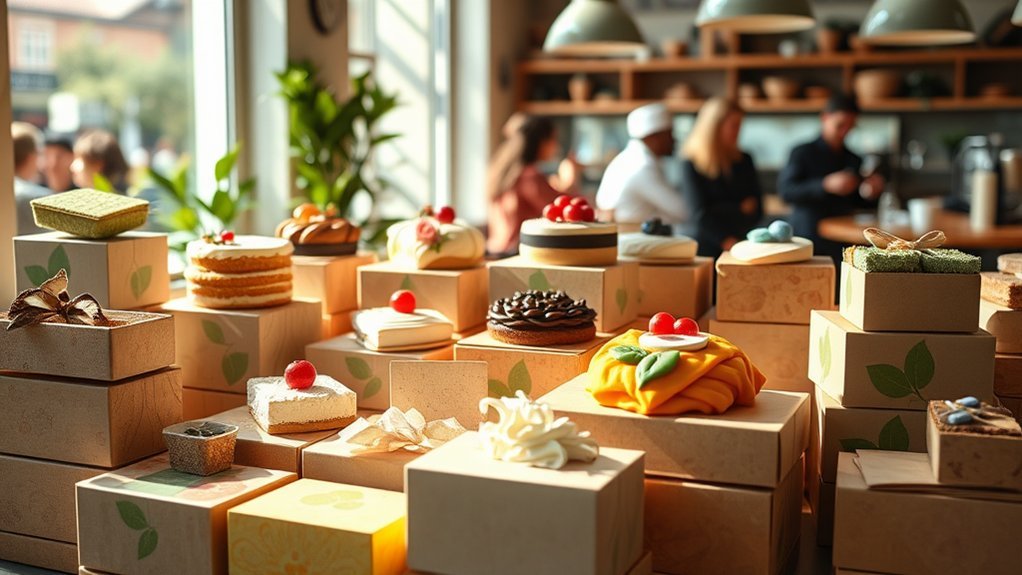
Sustainable packaging may seem like a passing trend, but it offers substantial economic benefits that can improve your business’s financial health.
By adopting sustainable solutions, you can:
- Save costs by using less material and reducing shipping expenses.
- Boost brand loyalty as consumers increasingly prefer eco-friendly practices.
- Increase efficiency in production, which helps streamline operations and minimise waste.
Investing in innovative packaging aligns with contemporary values and can enhance your profit margins over time.
By focusing on sustainable material sourcing, you’ll experience long-term financial gains that surpass initial investments.
Ultimately, your dedication to sustainability benefits both your business and the environment, creating a win-win scenario.
Navigating Regulatory Pressures and Compliance
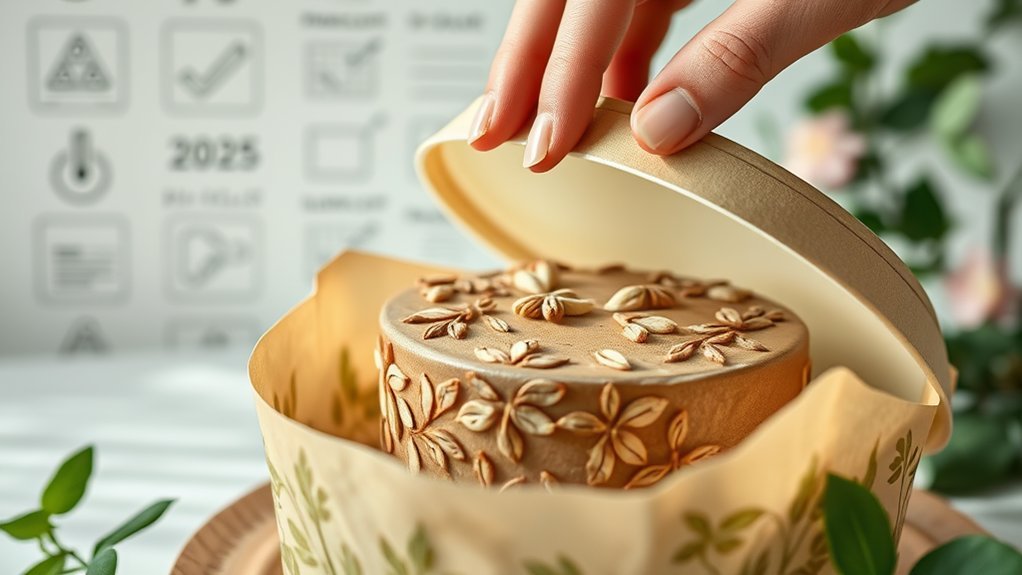
Navigating the regulatory landscape for sustainable cake packaging in the UK requires staying updated on changing laws.
To ensure compliance, consider adopting recyclability standards and managing the entire lifecycle of your packaging.
For instance, using materials that can be easily recycled not only helps you meet legal requirements but also appeals to environmentally conscious consumers.
Regulatory Landscape Overview
Navigating the regulatory landscape for sustainable cake packaging is crucial for bakers looking to comply with regulations and meet consumer expectations.
Here are key compliance measures to consider:
- UK Packaging Regulations: By 2026, ensure your packaging is sustainable and recyclable to meet UK standards.
- Extended Producer Responsibility (EPR): In regions like England, you’ll be responsible for managing the entire lifecycle of your packaging, from production to disposal.
- Material Adaptation: Transition to biodegradable materials while ensuring food safety is maintained.
These regulations not only promote sustainability but also cater to the increasing consumer demand for eco-friendly options.
Keeping abreast of these guidelines will help you better serve your customers and strengthen brand loyalty in a changing market.
Compliance Strategies for Brands
Navigating regulatory pressures can be daunting, but effective compliance strategies are essential for brands dedicated to sustainable cake packaging. Start with packaging audits to pinpoint non-compliant materials, and collaborate with eco-friendly suppliers offering sustainable alternatives. Redesign your packaging with a focus on efficiency and minimalism, ensuring it still provides adequate protection.
Here’s a straightforward reference table:
| Strategy | Action Item |
|---|---|
| Conduct Packaging Audits | Review current materials and processes |
| Partner with Eco-Friendly Suppliers | Work with vendors for sustainable materials |
| Monitor Regulatory Updates | Keep up-to-date with changing regulations |
| Invest in Material Innovation | Look into biodegradable and recyclable options |
Building Brand Loyalty Through Sustainable Practices
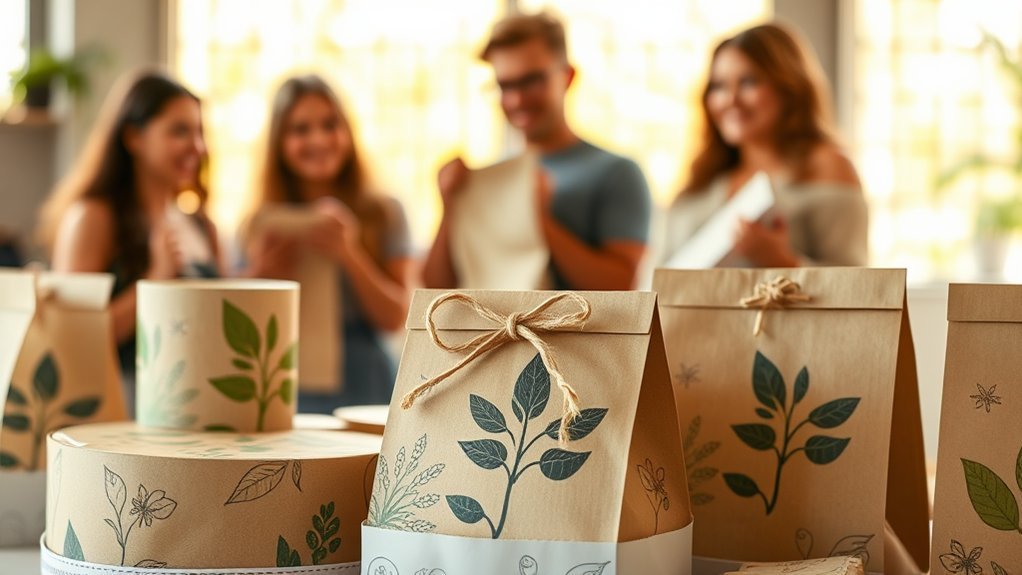
When consumers notice a brand dedicated to sustainable practices, they’re more inclined to form a lasting connection.
Sustainable branding resonates with their values and nurtures consumer loyalty. Here are some effective ways to strengthen that bond:
- Eco-Friendly Choices: Provide sustainable packaging that appeals to your audience’s desire to minimise waste.
- Transparency: Be open about your sustainability efforts; customers value honesty and accountability.
- Community Engagement: Involve customers in your green initiatives, helping them feel part of the solution.
The Future of Cake Packaging: Trends to Watch in 2025
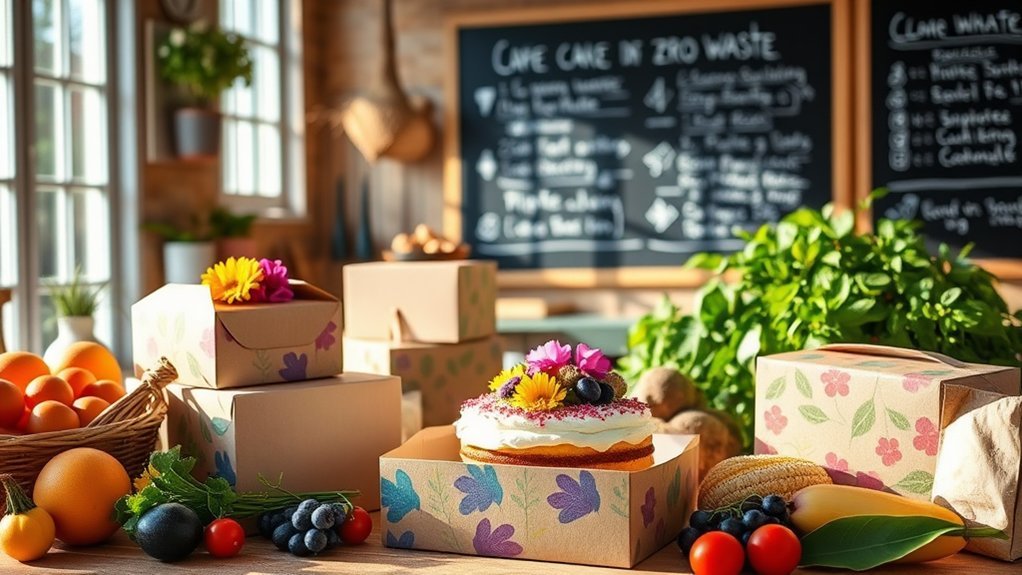
As the cake industry progresses, packaging trends for 2025 will focus heavily on sustainability and consumer engagement.
Expect a noticeable shift towards eco-friendly materials, such as biodegradable wrappers and compostable containers, which appeal to environmentally conscious shoppers. Research shows that around 70% of consumers are willing to pay a premium for sustainable options, prompting brands to adapt accordingly.
Look for clean, minimalist packaging designs that communicate purity and help distinguish brands.
Interactive elements, like QR codes and augmented reality features, will enhance consumer engagement by providing information on ingredients and sustainability efforts.
Frequently Asked Questions
What Types of Materials Are Considered Sustainable for Cake Packaging?
When selecting sustainable cake packaging, opt for biodegradable materials like cornstarch or bagasse, alongside recyclable options such as recycled cardboard and kraft paper. These choices minimise waste and support a healthier environment.
How Can I Properly Dispose of Sustainable Cake Packaging?
To properly dispose of sustainable cake packaging, start by cleaning off any leftover cake residues. Then, sort the materials according to local recycling guidelines. For compostable items, consider adding them to your compost bin if your local council allows it. By doing this, you support the natural cycle and contribute to a healthier environment.
Are There Certifications for Eco-Friendly Cake Packaging?
Yes, there are several eco-label certifications for cake packaging in the UK. Look for biodegradable standards such as the Forest Stewardship Council (FSC) and Certified Compostable labels. These certifications ensure that your packaging meets sustainability goals and promotes responsible sourcing.
What Is the Cost Difference Between Traditional and Sustainable Cake Packaging?
In today’s cost analysis, traditional cake packaging may seem cheaper at first glance. However, sustainable options are becoming increasingly innovative and can lead to long-term savings. Eco-friendly materials appeal to conscious consumers, helping to balance costs effectively. For instance, while a cardboard box might cost slightly more than plastic, it’s recyclable and aligns with eco-friendly values, potentially attracting more customers.
How Can Sustainable Packaging Impact Cake Freshness and Quality?
Sustainable packaging significantly improves the quality and freshness of cakes by keeping out moisture and air. This means your cakes stay fresh for longer, with a better texture and flavour — perfect for impressing your guests.
Conclusion
As we enter 2025, adopting sustainable cake packaging is no longer just a trend; it’s essential. Take, for instance, a bakery that switched to biodegradable packaging and experienced a 30% boost in sales within months, thanks to eco-conscious customers. By prioritising sustainability, you not only meet consumer expectations but also build brand loyalty and differentiate yourself in a crowded market. Embracing these practices now ensures a brighter future for both your business and the planet.

